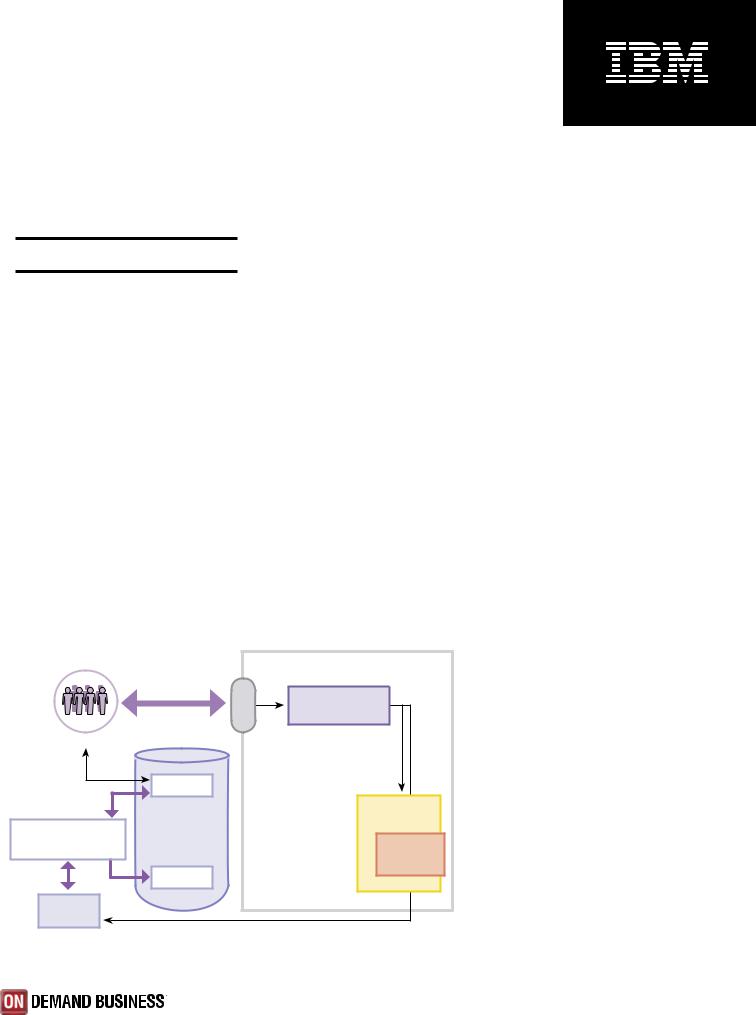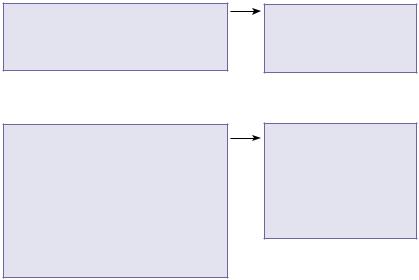IBM CICS Transaction Server User Manual

Offering easier integration with Web services, enhanced application transformation, and improved performance and enterprise-management capabilities
IBM CICS Transaction Server for z/OS,
Version 3.1
Highlights
Delivers CICS integration to enable reuse of CICS applications within broader, on demand scenarios, through standard APIs and protocols
Provides application-transformation capabilities that enable you to enhance existing applications and construct new applications, using contemporary programming languages, constructs and tools
Offers enterprise-management capabilities to help you effectively manage large run-time configurations using modern user interfaces, so you can meet demanding service-level objectives
Manyenterpriseshaveassessed theopportunitiesandadvantages presentedbyondemandbusiness
technologies.Now,they’reaggressively movingforwardtoimplement
flexiblebusinessprocessesthattake advantageofnewtechnologies,while stillleveragingexistingITassets.With thisflexiblearchitectureinplace, companiescangainthemomentum theyneedtoachievecompetitive advantageinthemarketplace.To keeppace,youmustensurethatyour businessprocessesintegrateacross yourcompanyandwithpartners, suppliersandcustomersbybuilding anecosystemthatcanrespondtoany marketopportunityorcompetitivethreat.
|
|
CICS Transaction Server Version 3.1 |
|
SOAP |
|
|
message |
Web services |
|
|
|
|
|
support |
Service requester |
|
|
|
HFS |
|
|
WSDL |
|
|
|
Data mapping |
CICS Web |
|
|
services assistant |
|
Business |
|
|
logic |
|
WSBind |
|
Language |
|
|
structure |
|
|
The industry-leading transactionprocessing platform
Withthisrelease,IBMCICS® TransactionServer,Version3.1provides theflexibleplatformyouneedtomove yourorganizationtowardbecoming
anondemandbusiness.Tohelpyou createanondemandoperating environment,CICSTransactionServer, Version3.1providesarangeofmajor enhancementsthatcanbegrouped intothreeprimaryareas:
•Increased integration of CICS applications
•Enhanced application transformation
•Improved performance and enterprise management
Throughtheseenhancements,CICS
TransactionServer,Version3.1can:
•Integrate with modern development environments, helping to reduce the cost of producing new technology solutions and the time to market for production of traditional applications.
•Enable new Java™ applications to extend the value of existing applications with their proven, operational business logic, while minimizing your risk .
CICS Transaction Server extends its support for Web services technology.
•Enable you to create adapters to integrate business applications, providing effective reuse of existing assets. Consolidating integration activities in the host environment helps you reduce risk and complexity, as well as the cost of creating point-to-point integration solutions.
•Help you earn a rapid return on investment (ROI) by providing a range of new capabilities that you can use immediately. Through system configuration, you can help improve service to the business and reduce computing costs from the day
of adoption.
Increased integration of CICS applications
These enhancements include facilities to reuse CICS applications within broader on demand business scenarios, using standard interfaces— primarily Web services and Java 2 Platform, Enterprise Edition (J2EE) connectors—and other industry communication protocols.
Web services support
CICS Transaction Server, Version 3.1 extends its Web services support beyond the Simple Object Access Protocol (SOAP) for CICS function that was available optionally with IBM CICS Transaction Server, Version 2. Together
with a range of extensions and new capabilities, this support now enables CICS business logic to be exposed as Web services, as part of a serviceoriented architecture (SOA). These extensions include support for WS-Security to help protect SOAP messages. Support is also provided for distributed transaction-coordination capability compatible with the WSAtomic Transaction specification
to help ensure that CICS Transaction Server can adhere to Web services standards.
CICS applications can naturally act in the role of both service provider and service requester, in cases where the services are defined using Web Services Description Language (WSDL). The ability of CICS Transaction Server to act as a service provider means that it is relatively simple for you to transform an existing CICS application into a Web service. The ability of CICS Transaction Server to act as a service requester means that a CICS application can issue
a single CICS command to use a Web service provided by any external provider.
To ease your ability to transform a CICS application into a Web service, IBM has included the CICS Web Services Assistant, a build-time capability provided to create WSDL
document from a simple language structure, or a language structure from an existing WSDL document. This support is provided for COBOL, C/C++ and PL/I. The assistant also generates information used to enable automatic run-time conversion between SOAP messages and containers and COMMAREAs. These capabilities help ensure that you do not have to write your own code to parse inbound messages and to construct outbound messages.
Enhanced HTTP support
CICS Web support is enhanced by upgrading CICS Transaction Server HTTP support to comply with the HTTP, Version 1.1 specification. Outbound HTTP support has also been added, so that CICS can act as both an HTTP server or as an HTTP client using simple EXEC CICS commands.
CICS Transaction Server also supports pipelining and chunking of messages. You can use new resource definitions, known as uriMAP definitions, to manage the HTTP server facility without needing to customize your analyzer program. CICS Transaction Server automatically creates virtual hosts using these definitions, so multiple host
2
names can be provided at the same Internet Protocol (IP) address, which you can manage using CICS system commands. Static responses can be provided for HTTP requests, formed from a document template or hierarchical file system (HFS) file. This means that you can write CICS application programs to use a common protocol for business-to-business (B2B) communication, control hardware or software using HTTP, and access information in non-WebbrowserHTTPapplications.
Improved connected, but inactive, sockets allow many more clients to connect to each CICS system. Using an internal pseudo-conversational model, no CICS task resources are consumed by sockets waiting for the next message from a partner. Use of this model simplifies managing task resources within a CICS environment.
Improvements to SSL support
CICS Transaction Server, Version 3.1 introduces a range of improvements to security. Besides its existing support for Secure Sockets Layer (SSL), Version 3.0, CICS Transaction Server now supports the Transport Layer Security (TLS), Version 1.0 protocol. This includes support for the Advanced Encryption Standard (AES) cipher suites that offer 128-bit and 256-bit encryption.
Resource definitions for TCP/IP service and CORBA Server are enhanced to allow the user to specify the precise list of cipher suites to be used in the negotiation. This capability is also included in the new uriMAP resource definition. To support management of these new capabilities and resources, CICS Transaction Server, Version 3.1 includes new system programming interface
(SPI) commands.
CICS Transaction Server, Version 3.1 now supports certificate revocation lists (CRLs) when negotiating with clients, allowing any connections using revoked certificates to be closed immediately. A new transaction, CCRL, is provided to update the CRL in the Lightweight Directory Access Protocol (LDAP) server. These negotiations offer more flexibility. Now, you can specify a minimum, as well as a maximum, encryption level to negotiate with particular users.
You can also specify whether session IDs are shared across an IBM Parallel Sysplex® environment, improving the current use of the cache at the
address-space level. Caching enables an SSL handshake to be optimized based on a previous negotiation, helping to improve the performance of the connection setup.
An increased number of simultaneous SSL connections can now be used, as a result of the introduction of support for pthreads within the IBM Language Environment® enclave from which system SSL is invoked. With this support, your system can achieve better throughput and improve the support for new functions such as Web services.
Support for mixed-case passwords
CICS Transaction Server, Version 3.1 now supports an underlying capability for case-sensitive passwords. When this capability is active, it is indicated on the sign-on panel supplied by CICS Transaction Server.
Improved user-ID checks
The revoked status of a user-ID or group connection is now tested by the EXEC CICS START USERID() command at the time it is issued, so that the issuer can be notified by the USERIDERR command if applicable.
Application transformation
CICS Transaction Server, Version 3.1 includes enhancements that help you extend existing applications and develop new applications, using contemporary programming languages, constructs and tools.
3

Enhanced interprogram data transfer
If you want to exchange more than 32KB of data between programs, CICS Transaction Server now includes a new application programming interface (API), which introduces containers and channels. Containers are named blocks of data for passing information between programs. Any number of containers can be passed between programs.
Containers are grouped together in named channels. Channels can be used as a standard mechanism for exchanging data between programs. A channel can be passed on EXEC CICS LINK, START, XCTL and
RETURN commands. Data can be exchanged between systems by either using multiregion option (MRO) or intersystem communication (ISC). Channels provide a more-flexible and a more-structured method of passing data between program components. Variation in the size and number of containers can conveniently be accommodated to allow easier evolution of the interfaces between programs. The size of a container is one accommodation, limited only by the amount of storage available. There is no limit to the number of containers that can be added to a channel. This mechanism also removes the need for programs to know the exact size of the data returned. When containers go out of scope, they can be automatically destroyed, relieving you of storagemanagement concerns.
Channels can be used by applications written in any of the programming languages supported by CICS Transaction Server, Version 3.1. Options on the container API commands are provided for data conversion, giving you a much-simpler mechanism than that employed with a COMMAREA. Also, in COMMAREAs, application data conversion is controlled by the system programmer. With channels, application-data conversion is controlled by the application programmer using simple API commands, minimizing the need to involve the system programmer.
Language Environment MAIN support for assembler
CICSTransactionServernowincludes supporttoenablecodingofcompletely Language Environment technology-
enabled application programs in assembler. A new translator option, LEASM, is provided, which causes Language Environment function to be used to set up the program’s environment. This option eases integration of these applications into Language Environment, so that Language Environment services can run more easily,andimprovesdebuggersupport.
64-bit addressing toleration
Although CICS Transaction Server, Version 3.1 does not support
the running of 64-bit applications, it now supports 64-bit code running
as task-related user exits (TRUEs) in a CICS address space. Extensions are provided to CICS Transaction Server abend-capture mechanisms to allow the contents of full 64-bit, generalpurpose registers to be reported.
Existing application with COMMAREA
Program A
EXEC CICS LINK PROGRAM(‘PROGRAMB’)
Changed application using
Program A
EXEC CICS PUT CONTAINER(structure name) CHANNEL(channel-name)
FROM(structure)
EXEC CICS LINK PROGRAM(‘PROGRAMB’)
CHANNEL(channel-name)
EXEC CICS GET CONTAINER(structure-name)
INTO(structure)
Program B
EXEC CICS ADDRESS
Program B
EXEC CICS GET CONTAINER(structurename)INTO(structure)
EXEC CICS PUT
CONTAINER(structure-name)
Restrictions on the amount of data that can be exchanged have been removed by using channels and containers.
4
